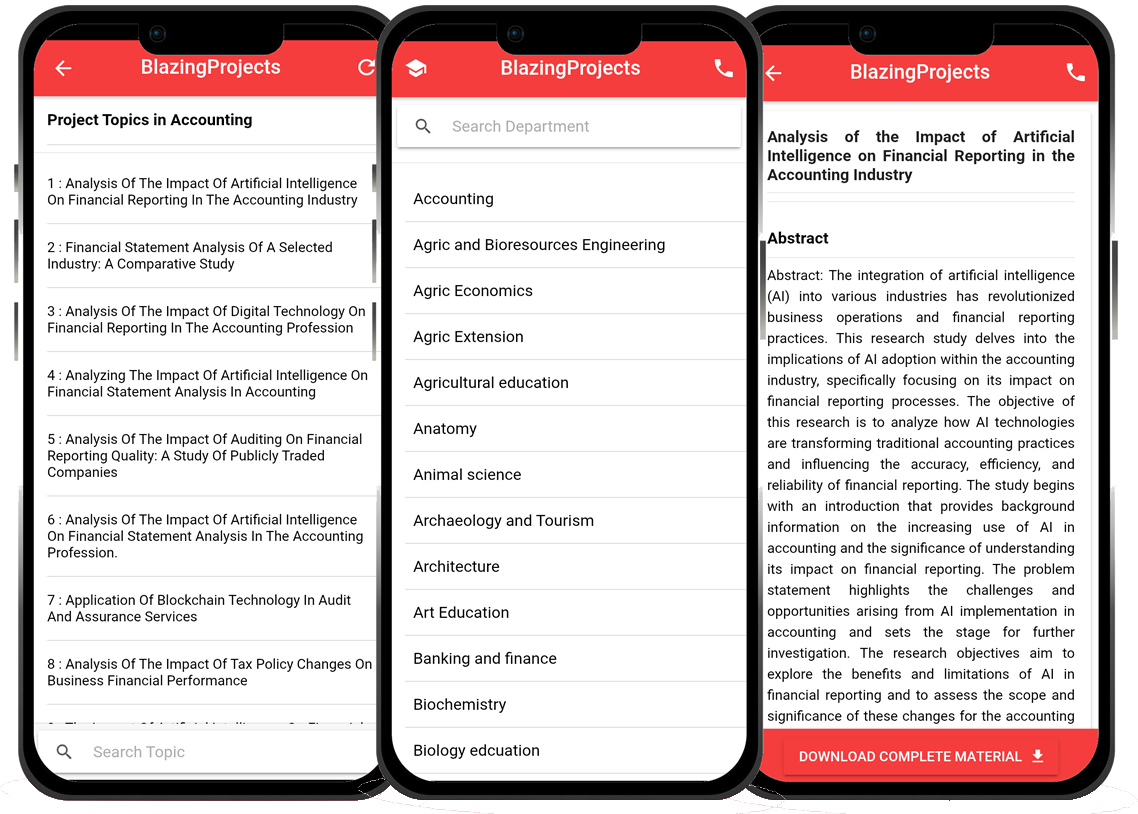Use of computer in classroom
Table Of Contents
Project Abstract
AbstractThe integration of computers in the classroom has become a prevalent topic in educational research and practice. This study aims to explore the impact of using computers in the classroom on student learning outcomes, engagement, and teacher effectiveness. By examining current literature on the subject, we identify the potential benefits and challenges associated with incorporating technology into the educational environment. Our research findings suggest that the use of computers in the classroom can enhance student learning by providing access to a wide range of resources, promoting interactive and collaborative activities, and catering to diverse learning styles. Additionally, technology integration has the potential to increase student engagement through interactive multimedia content, gamified learning experiences, and personalized learning pathways. However, challenges related to computer use in the classroom include issues such as access to technology, teacher training and support, digital equity, and concerns about screen time and distractions. Addressing these challenges requires a comprehensive approach that includes providing adequate resources, professional development opportunities for teachers, and equitable access to technology for all students. Furthermore, our study highlights the importance of effective pedagogical strategies when integrating computers into the classroom. Teachers play a crucial role in leveraging technology to enhance student learning experiences and must be equipped with the necessary skills to integrate technology effectively into their instructional practices. In conclusion, the use of computers in the classroom has the potential to transform traditional teaching and learning processes by providing innovative ways to engage students, personalize instruction, and foster 21st-century skills. However, to fully realize the benefits of technology integration, educators, policymakers, and school administrators must work together to address the challenges associated with implementing computer-based learning initiatives. Overall, this research contributes to the ongoing discussion on the role of technology in education and provides insights into best practices for integrating computers into the classroom to improve student outcomes and teacher effectiveness.
Project Overview
INTRODUCTION
Computers in the classroom include any digital technology used to enhance, supplement, or replace a traditional educational curriculum. As computers have become more accessible, inexpensive, and powerful, the demand for this technology has increased, leading to more frequent use of computer resources within classes, and a decrease in the student-to-computer ratio within schools.
College campuses used computer mainframes in education since the initial days of this technology, and throughout the initial development of computers. The earliest known large-scale study of educational computer usage conducted for the National Science Foundation by The American Institute for Research concluded that 13% of the nation’s public high schools used computers for instruction, although non-users still outnumbered users at a ratio of 2 to 1.
The study also concluded that computers proved to be very popular with students, and that applications run on early models included sports statistic managers, administration tools, and physics simulators.
Most schools will require teachers to incorporate computer use into the grade level curriculum. The new teacher may need assistance deciding how to do this on a daily basis. Some teachers are hesitant to introduce computer time into the classroom because they view this as a form of “free time” or they may not be confident in their own computing skills. However, when governed and lead properly, integrating computer time into the classroom will have several benefits.
Students gain word processing skills when learning to type: skills they will need in college and the workplace.
Working on computers fosters collaboration between students and between the student and teacher as they work together on projects.
Often leaders emerge who really enjoy computers and can help others, which is useful to classmates and the teacher.
Computer time promotes using higher order thinking skills and is a natural form of discovery through trial and error.
Computer time increases responsibility, independence and a sense of accomplishment.
Computers can reinforce instruction or are an assertive tool in the instruction through podcasts, video and multimedia.
Blazingprojects Mobile App
📚 Over 50,000 Project Materials
📱 100% Offline: No internet needed
📝 Over 98 Departments
🔍 Software coding and Machine construction
🎓 Postgraduate/Undergraduate Research works
📥 Instant Whatsapp/Email Delivery

Related Research
Predicting Disease Outbreaks Using Machine Learning and Data Analysis...
The project topic, "Predicting Disease Outbreaks Using Machine Learning and Data Analysis," focuses on utilizing advanced computational techniques to ...
Implementation of a Real-Time Facial Recognition System using Deep Learning Techniqu...
The project on "Implementation of a Real-Time Facial Recognition System using Deep Learning Techniques" aims to develop a sophisticated system that ca...
Applying Machine Learning for Network Intrusion Detection...
The project topic "Applying Machine Learning for Network Intrusion Detection" focuses on utilizing machine learning algorithms to enhance the detectio...
Analyzing and Improving Machine Learning Model Performance Using Explainable AI Tech...
The project topic "Analyzing and Improving Machine Learning Model Performance Using Explainable AI Techniques" focuses on enhancing the effectiveness ...
Applying Machine Learning Algorithms for Predicting Stock Market Trends...
The project topic "Applying Machine Learning Algorithms for Predicting Stock Market Trends" revolves around the application of cutting-edge machine le...
Application of Machine Learning for Predictive Maintenance in Industrial IoT Systems...
The project topic, "Application of Machine Learning for Predictive Maintenance in Industrial IoT Systems," focuses on the integration of machine learn...
Anomaly Detection in Internet of Things (IoT) Networks using Machine Learning Algori...
Anomaly detection in Internet of Things (IoT) networks using machine learning algorithms is a critical research area that aims to enhance the security and effic...
Anomaly Detection in Network Traffic Using Machine Learning Algorithms...
Anomaly detection in network traffic using machine learning algorithms is a crucial aspect of cybersecurity that aims to identify unusual patterns or behaviors ...
Predictive maintenance using machine learning algorithms...
Predictive maintenance is a proactive maintenance strategy that aims to predict equipment failures before they occur, thereby reducing downtime and maintenance ...